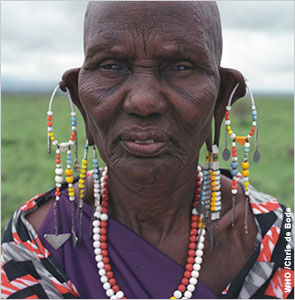Aid Accelerates for 1 Billion Afflicted by Tropical Diseases

This Tanzanian woman is blinded by trachoma and unable to pursue her livelihood — making the kind of jewelry she wears.
By Charlene Porter
IIP Staff Writer
Washington,
January 17, 2013
A broad coalition of governments, health agencies and private companies issued the London Declaration in January 2012, vowing to step up action on these diseases, aiming for the control and elimination of 10 NTDs by 2020. From Promises to Progress, issued by the coalition, finds “exciting progress,” with pharmaceutical partners in the coalition stepping up their donations of medicines to 1.12 billion treatments. Those commitments fulfilled the request from nations where the diseases are endemic and “removed a key bottleneck to the successful treatment and prevention of NTDs,” according to a press release about the report.
The coalition report also notes increased financial commitments from donor nations. The U.S. Agency for International Development (USAID) has steadily increased its donations in recent years to reach $89 million in 2012. The United Kingdom upped its NTD commitment to the equivalent of $42.5 million, a 70 percent increase over the U.K.’s 2011 support for NTD treatment and eradication.
The heightened focus on NTDs from the international community has sparked greater action from endemic nations, the coalition reports, with 40 nations drawing up multiyear plans for attacking NTDs.
“The prospects for success have never been so strong,” said Dr. Margaret Chan, director-general of the World Health Organization, which is responsible for outlining the targets for control and long-term elimination of NTDs. “Many millions of people are being freed from the misery and disability that have kept populations mired in poverty for centuries.”
USAID is working in 24 countries to combat NTDs, with populations that represent 41 percent of the global need.
“We are beginning to see control and elimination of these diseases in many countries,” said USAID’s Dr. Ariel Pablos-Mendez. “It’s a triumph of partnership — working together to create new medicines, get the drugs to the communities that need them, and enlist local support to ensure appropriateness of proposed interventions.” Mendez is the assistant administrator for global health at USAID.
These diseases sicken, disable and disfigure more than 1 billion people in 149 countries. Historical records document that some of these conditions have plagued humankind for millennia. While the diseases are not always fatal, they may cause lifelong disabilities that limit an individual’s opportunities and productivity. Economic analysts have found evidence that these diseases and resulting disabilities contribute to a persistent cycle of poverty that limits progress in some developing-world nations.
The 10 diseases targeted for elimination by 2020 include trachoma, which is the world’s leading cause of blindness, Chagas’ disease, guinea worm disease, sleeping sickness, elephantiasis, leprosy, river blindness, schistosomiasis, intestinal worms and visceral leishmaniasis.
The campaign against NTDs is also being pursued under the Global Health Initiative, launched by the Obama administration in 2009.
Other partners in the NTD coalition include the World Bank, the Bill & Melinda Gates Foundation and an array of companies representing the pharmaceutical industry, including AstraZeneca, Bayer, Merck, Pfizer and Sanofi.
 Print
Print
